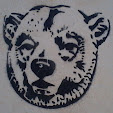However there are so many in the queue we
will still have the odd one though the year - as always!
This is interesting not for the toy
animals, which are a typical set of mini, soft PVC-alike rack toy generics, but
for the false-plant/fish-tank accessories thrown-in as
make-weights/volume-fillers, but we'll have a quick look at the livestock first
. . .
. . . all eight of them! Ignoring the facts
that they are not in scale and that the kangaroo has sloth lichen in his fur
(the elephant's aluminium, and the lion gold so why not!), they can be seen as
reasonable for what they are, the llama type is unusual and both the bear and
the lion are also nice sculpts.
I have - still in Picasa from last year - a
folder called 'RTM- Henbandt et al' which deals with about ten or eleven of
these sets, it's now penciled-in for next August, but I may try and get it done
in the next few weeks so's to compare with this lot, who ended up getting their
own post, due to the plants.
The 'plants' are three plug-in sections of
larger synthetic plants/artificial flowers, although - from the leery colours - I suspect
fish-tanks as an end destination for the bulk of the production, however a few
ended up in these blisters, and while on one level fruitless fillers with no
means of being stood-up as 'trees' they are very interesting from a technical
point of view.
The easier to understand are these, where
it would appear a twin-nozzle injector-head is used to fire a shot of yellow (or
light green) polyethylene, followed (instantly?) by a shot of red (or dark green), the second shot
pushing the first up the cavity as it mixes with it for yellow-orange-red or
gradated green effects.
This however, presents one with more of a
headache, as it appears that the (and this is all guesswork on both types)
green is shot to almost full-cavity, then a jacket of red is shot over it, but
it's not over-moulding as the green survives at the tips of the leaves and is
visible under the red at the branch-joints and end-plug/loop.
I can only guess that the green goes in at under-[optimum]-pressure,
then the red is immediately shot at a higher over-or-optimum-pressure, slipping
over the top or 'surface' of the green, but also pushing the green into the
tips?
It may be that a red polymer-stain/colorant
is injected into the mould before the green has fully-cooled, but it's not
clear, and both aught to lead to more/redder leaves nearer the gate at the
end-plug/loop?
Either way it's very clever and I'd be
interested to know more, however the way other posts here looking at technical
aspects have resulted in further work appearing elsewhere, I'm sure someone
will go and find out and wax-knowledgeable, in the near future?
I haven't got the time; next week we are World
War II box-ticking and while I have the images, I haven't done the blurbs yet! Some clues here . . .
. . . suggest it's a form of 'bi-injection'?








No comments:
Post a Comment